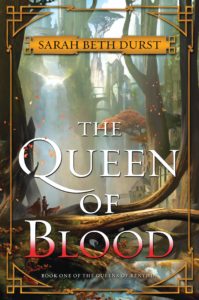In Renthia, a land divided into 5 nations, six kinds of spirits make plants grow, fire burn, water flow — and all six kinds of spirits would gladly tear every human on the continent to pieces. The only person who holds them at bay is the queen of each nation, a magically-gifted woman chosen by the spirits as the strongest in the land, and each queen must have heirs trained and prepared in case of her death.
Daleina discovered her magical abilities when she was able to protect her family during a horrific spirit attack that destroyed their village, and she’s concluded that it’s her destiny — her responsibility — to become one of Queen Fara’s heirs. The Queen of Blood follows this journey as she enters Northeast Academy in Aratay for the training that will make her an heir.
 As a preface, fantasy is typically not my strongest suit, because I’m extremely picky about worldbuilding, which pretty much everyone in the Girls in Capes Book Club knows by now. I’m also not usually a fan of sword and sorcery titles, either, which I originally assumed the book fell into categorically, but reviewed the title based on the premise of a highly matriarchal society and a young woman’s more or less solo adventure.
As a preface, fantasy is typically not my strongest suit, because I’m extremely picky about worldbuilding, which pretty much everyone in the Girls in Capes Book Club knows by now. I’m also not usually a fan of sword and sorcery titles, either, which I originally assumed the book fell into categorically, but reviewed the title based on the premise of a highly matriarchal society and a young woman’s more or less solo adventure.
The Queen of Blood was nothing at all like I expected, from the universe to the characters themselves, and it’s absolutely something I’d recommend to other readers.
Though the cover copy outlines just about the same information as in my summary above, one of the most important parts of the book isn’t mentioned at all: while most fantasy stories follow a Chosen One or someone magically gifted far beyond the average person, Daleina not only isn’t a Chosen One, she honestly kind of sucks at magic, which is addressed by the end of the first chapter. She lacks in raw power, and the type of magic she’s best at isn’t one that the academy teaches or really even seems to recognize at all.
Daleina is one of the most likable things about the book. Aside from her magical mediocrity, she’s actually an excellent candidate for a ruler, and she’s the sort of ruler I would want for my own country: she cares mainly about protecting the people of Aratay from the destruction the spirits want to bring to humanity, whereas many of the other candidates are concerned with things like personal power, prestige, and status.
Another part of the book I found very enjoyable was the worldbuilding (in a move that surprises no one). Durst has crafted a world with rules that largely make sense in and of themselves; though there are a few holes and gaps in logic — there doesn’t seem to be any system in place for assigning women with magic to the places that need to be protected, which seems like an inherent bureaucratic flaw — The Queen of Blood ultimately leaves more answers than questions.
Surprisingly, the book also addresses an issue in contemporary education. As I mentioned above, the type of magic Daleina excels in isn’t taught at the academy, and when she finally leaves the academy and begins doing work on her own, her mentor points out the academy cares more about methodology — doing it “right” — than the results, which is what reality favors. I admit that I’m biased here: this closely mirrors my own experiences, especially in grade school, when I was told pretty frequently by teachers that I needed to do things the way they were taught, regardless of whether the outcome was correct.
The Queen of Blood is, as the title suggests, a bit of a bloodfest — but since it’s a book that deals largely with humanity’s survival in the face of wild creature attacks, that’s absolutely expected. The series is surprisingly addictive — I read the entire book in one day and started the second one almost as soon as I finished. With the conclusion to the trilogy, The Queen of Sorrow, arriving this May, it’s a perfect time to pick up the series.
4.5 out of 5 stars
Goodreads | Indiebound | Kobo
This review contains affiliate links. While Girls in Capes does make revenue from purchases made at affiliate links, reviews are not paid, and all reviews contain the staff writers’ honest opinions of the work.





